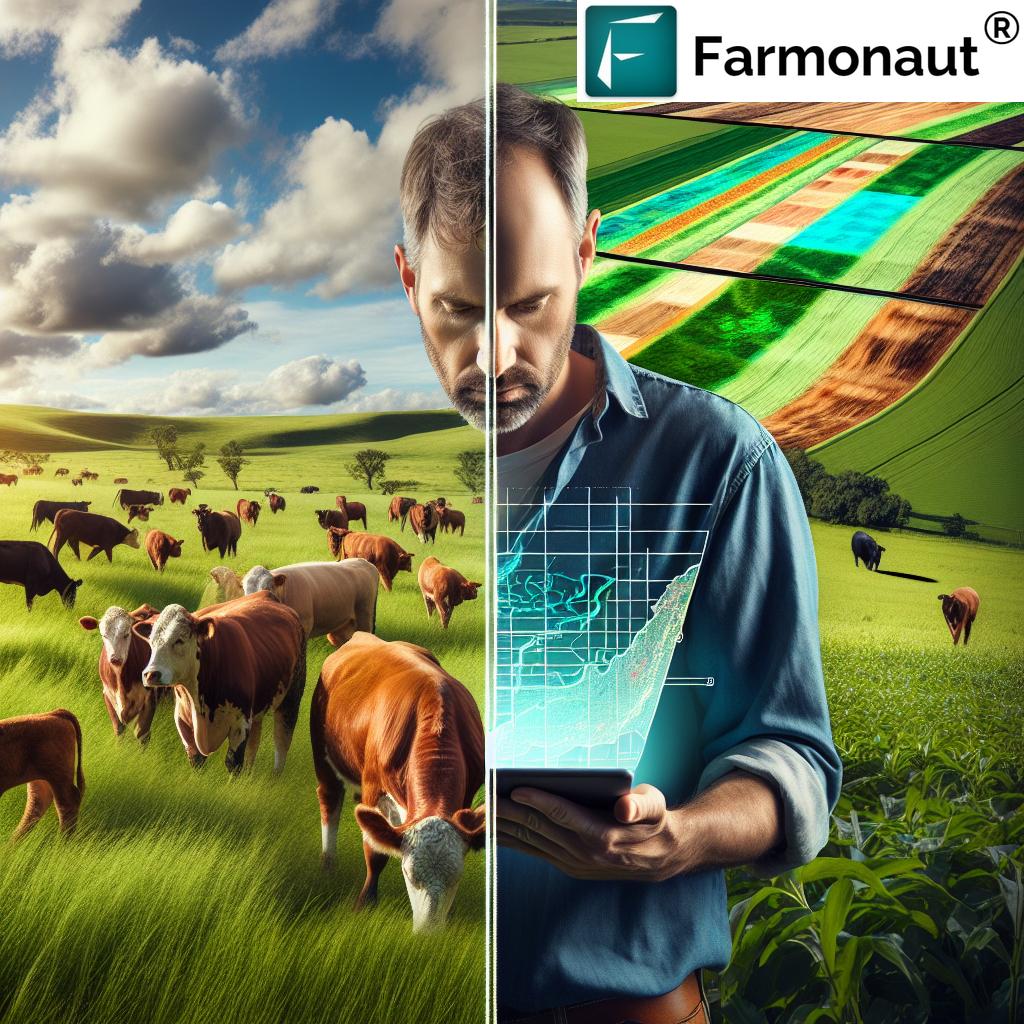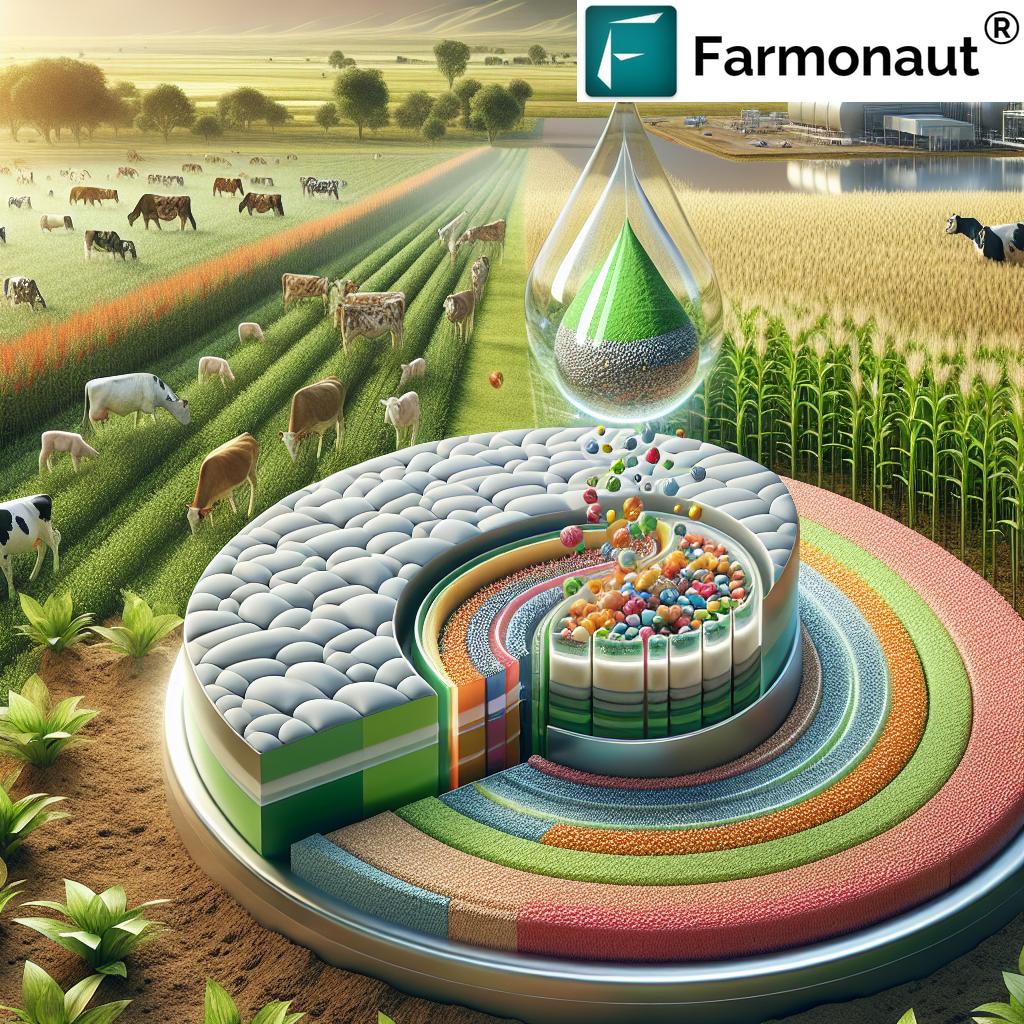Revolutionizing UK Livestock Fertility: Innovative GIS-Powered Agricultural Technology for Sustainable Farming
“GIS-powered agricultural technology has increased livestock fertility rates by up to 25% in UK farms.”
In the ever-evolving landscape of agriculture, we’re witnessing a remarkable transformation in livestock fertility management and precision farming techniques. As we delve into the world of agricultural technology innovations, we’ll explore how these advancements are reshaping the future of farming in the United Kingdom and beyond. From controlled release bolus technology to the integration of Geographic Information Systems (GIS) in agriculture, we’re on the cusp of a revolution that promises to enhance farm efficiency, animal welfare, and overall agricultural sustainability.
The Dawn of Precision Livestock Farming
Precision livestock farming is at the forefront of agricultural technology innovations, offering farmers unprecedented control and insight into their operations. By harnessing the power of data-driven decision-making, we’re seeing significant improvements in livestock fertility management and overall farm productivity.

One of the most exciting developments in this field is the controlled release bolus technology. This innovative approach to livestock nutrition is revolutionizing how we manage animal health and fertility. Let’s explore how this technology works and its impact on sustainable livestock production.
Controlled Release Bolus: A Game-Changer in Animal Nutrition
The controlled release bolus is a sophisticated delivery system that combines essential trace elements with soluble glass technology. This unique combination ensures that animals receive a steady, optimal release of nutrients throughout the bolus’s lifetime, which can extend up to 180 days or more.
“Controlled release boluses can provide essential trace elements to livestock for over 180 days continuously.”
Key benefits of controlled release bolus technology include:
- Consistent nutrient delivery over an extended period
- Improved weight gain in farm animals
- Enhanced fertility rates in livestock
- Reduced labor and handling stress for animals
- Customizable formulations to meet specific nutritional needs
This innovative approach to livestock nutrition addresses one of the most critical aspects of animal health: the role of trace elements in fertility and overall well-being.
The Critical Role of Trace Elements in Animal Nutrition
Trace elements play a vital role in numerous physiological processes in livestock, including reproduction, growth, and immune function. Among these, copper stands out as particularly crucial for cattle health and fertility.
Copper deficiency in cattle can lead to:
- Reduced fertility rates
- Decreased milk production
- Weakened immune systems
- Poor growth and development
By utilizing controlled release bolus technology, farmers can effectively address copper deficiency and other trace element imbalances, ensuring their livestock maintain optimal health and productivity.
GIS in Agriculture: Transforming Farm Management Practices
As we continue to explore agricultural technology innovations, we cannot overlook the transformative impact of Geographic Information Systems (GIS) in agriculture. GIS technology is revolutionizing how farmers manage their land, crops, and livestock, offering unprecedented insights and control over farm operations.
Key applications of GIS in agriculture include:
- Precision mapping of farm layouts and soil composition
- Real-time monitoring of crop health and livestock movements
- Optimized resource allocation for irrigation and fertilizer application
- Enhanced pest and disease management strategies
- Improved yield forecasting and harvest planning
By integrating GIS technology with livestock fertility management practices, farmers can achieve new levels of efficiency and sustainability in their operations.
Precision Farming Techniques: A Synergy of Technology and Tradition
Precision farming techniques represent the perfect blend of cutting-edge technology and time-honored agricultural wisdom. These methods allow farmers to make data-driven decisions that optimize resource use while maximizing yields and animal welfare.
Some key precision farming techniques include:
- Variable rate technology for targeted application of inputs
- Remote sensing for early detection of crop stress or animal health issues
- Automated systems for livestock feeding and monitoring
- GPS-guided machinery for efficient field operations
- Data analytics for predictive modeling and decision support
By embracing these precision farming techniques, UK farmers are positioning themselves at the forefront of sustainable agriculture and efficient livestock management.
Sustainable Livestock Production: Balancing Productivity and Environmental Stewardship
As we strive for increased agricultural productivity, it’s crucial to maintain a focus on sustainability. Sustainable livestock production methods are essential for ensuring long-term food security while minimizing environmental impact.

Key aspects of sustainable livestock production include:
- Efficient use of resources through precision farming techniques
- Improved animal welfare through better nutrition and health management
- Reduced environmental impact through optimized feed conversion ratios
- Integration of renewable energy sources in farm operations
- Implementation of waste management and recycling systems
By leveraging agricultural technology innovations, farmers can achieve a balance between productivity and environmental stewardship, ensuring the long-term viability of their operations.
Agricultural Nutrient Management: Optimizing Inputs for Maximum Efficiency
Effective agricultural nutrient management is crucial for maintaining soil health, optimizing crop yields, and ensuring the well-being of livestock. Advanced technologies are playing an increasingly important role in this aspect of farm management.
Key strategies for agricultural nutrient management include:
- Soil testing and analysis for precise nutrient application
- Use of controlled release fertilizers and trace element supplements
- Implementation of crop rotation and cover cropping practices
- Integration of livestock and crop production systems
- Utilization of GIS for targeted nutrient application
By adopting these strategies, farmers can reduce input costs, minimize environmental impact, and improve overall farm productivity.
The Role of Technology in Revolutionizing UK Farming
As we continue to explore the impact of agricultural technology innovations on UK farming, it’s clear that the integration of advanced tools and techniques is transforming the industry. From small family farms to large-scale agricultural operations, technology is playing a crucial role in improving efficiency, sustainability, and profitability.
Key technological advancements shaping UK farming include:
- Satellite-based crop monitoring systems
- AI-powered decision support tools
- Blockchain-based traceability solutions
- Autonomous farm machinery
- Advanced weather forecasting and climate modeling
These technologies are not only enhancing livestock fertility management but also revolutionizing every aspect of farm operations.
The Impact of GIS on Land Management and Farm Planning
Geographic Information Systems (GIS) have become indispensable tools for modern farmers, offering unprecedented insights into land use, resource allocation, and farm planning. By leveraging GIS technology, farmers can make more informed decisions about crop rotation, livestock grazing patterns, and overall farm layout.
Benefits of GIS in farm planning include:
- Accurate mapping of soil types and topography
- Optimization of field boundaries and access routes
- Improved water management and drainage planning
- Enhanced crop yield forecasting
- Better integration of conservation areas within farmland
These capabilities allow farmers to maximize the productive potential of their land while maintaining sustainable practices.
The Future of Livestock Fertility Management
As we look to the future of livestock fertility management, it’s clear that the integration of advanced technologies will continue to play a crucial role. From genomic selection to AI-powered health monitoring systems, the possibilities for improving animal welfare and productivity are endless.
Some emerging trends in livestock fertility management include:
- Use of wearable sensors for real-time health and fertility monitoring
- Implementation of precision livestock farming techniques
- Development of customized nutrition plans based on genetic profiles
- Integration of virtual and augmented reality for farm management
- Adoption of robotic systems for routine farm tasks
These advancements promise to further revolutionize the way we approach livestock fertility and overall farm management.
The Role of Data in Modern Agriculture
In the era of big data and advanced analytics, the ability to collect, process, and interpret vast amounts of information is transforming agriculture. From soil sensors to satellite imagery, farmers now have access to an unprecedented wealth of data to inform their decision-making processes.
Key areas where data is driving agricultural innovation include:
- Predictive modeling for crop yields and livestock performance
- Real-time monitoring of animal health and behavior
- Optimization of resource allocation and input use
- Market trend analysis for better pricing and distribution strategies
- Environmental impact assessment and sustainability reporting
By harnessing the power of data, farmers can make more informed decisions, reduce risks, and improve overall farm efficiency.
Comparative Analysis: Traditional vs. GIS-Powered Livestock Fertility Management
To better understand the impact of GIS-powered innovations on livestock fertility management, let’s compare traditional methods with modern, technology-driven approaches:
| Fertility Management Aspect | Traditional Method | GIS-Powered Innovation | Benefits of GIS Approach |
|---|---|---|---|
| Nutrient Delivery | Manual supplementation | Controlled release bolus technology | Consistent, long-term nutrient supply; reduced labor |
| Trace Element Monitoring | Periodic blood tests | Real-time sensor data analysis | Early detection of deficiencies; proactive management |
| Weight Gain Tracking | Manual weighing | Automated weight monitoring systems | Continuous data collection; stress reduction for animals |
| Fertility Rate Improvement | Generalized breeding programs | AI-driven individual animal analysis | Optimized breeding schedules; higher success rates |
| Farm Efficiency | Experience-based decision making | Data-driven resource allocation | Improved resource utilization; cost reduction |
| Sustainability Impact | Limited environmental considerations | Integrated ecosystem management | Reduced environmental footprint; improved long-term viability |
This comparison clearly illustrates the significant advantages that GIS-powered innovations bring to livestock fertility management and overall farm operations.
Embracing Innovation: The Path Forward for UK Agriculture
As we’ve explored throughout this article, the integration of advanced technologies like controlled release bolus systems, GIS, and precision farming techniques is revolutionizing UK agriculture. These innovations are not just improving livestock fertility and farm productivity; they’re paving the way for a more sustainable and resilient agricultural sector.
Key takeaways for UK farmers and agricultural professionals:
- Embrace technology as a tool for enhancing traditional farming practices
- Invest in continuous learning and skill development to keep pace with innovations
- Collaborate with research institutions and technology providers to drive innovation
- Prioritize sustainability alongside productivity in all farming decisions
- Leverage data-driven insights to make informed management choices
By adopting these principles and embracing the latest agricultural technology innovations, UK farmers can position themselves at the forefront of global agriculture, ensuring a prosperous and sustainable future for generations to come.
FAQ Section
Q: What is controlled release bolus technology?
A: Controlled release bolus technology is an innovative nutrient delivery system for livestock that combines trace elements with soluble glass, ensuring a steady release of essential nutrients over an extended period, typically up to 180 days or more.
Q: How does GIS technology benefit agriculture?
A: GIS technology in agriculture offers benefits such as precise mapping of farm layouts, real-time crop and livestock monitoring, optimized resource allocation, enhanced pest management, and improved yield forecasting.
Q: What are the key components of sustainable livestock production?
A: Sustainable livestock production involves efficient resource use, improved animal welfare, reduced environmental impact, integration of renewable energy, and implementation of effective waste management systems.
Q: How does precision farming contribute to agricultural efficiency?
A: Precision farming techniques, such as variable rate technology, remote sensing, and GPS-guided machinery, allow for targeted application of inputs, early detection of issues, and overall improved efficiency in farm operations.
Q: What role does data play in modern agriculture?
A: Data in modern agriculture drives innovation through predictive modeling, real-time monitoring, resource optimization, market analysis, and environmental impact assessment, enabling farmers to make more informed decisions and improve overall farm efficiency.
For those looking to leverage cutting-edge agricultural technology in their operations, Farmonaut offers advanced satellite-based farm management solutions. Access their services through their API or explore their API Developer Docs for integration options.
Download the Farmonaut app for on-the-go farm management:
In conclusion, the future of UK agriculture is bright, driven by innovative technologies and sustainable practices. By embracing these advancements, farmers can ensure the long-term viability of their operations while contributing to a more sustainable and productive agricultural sector.





